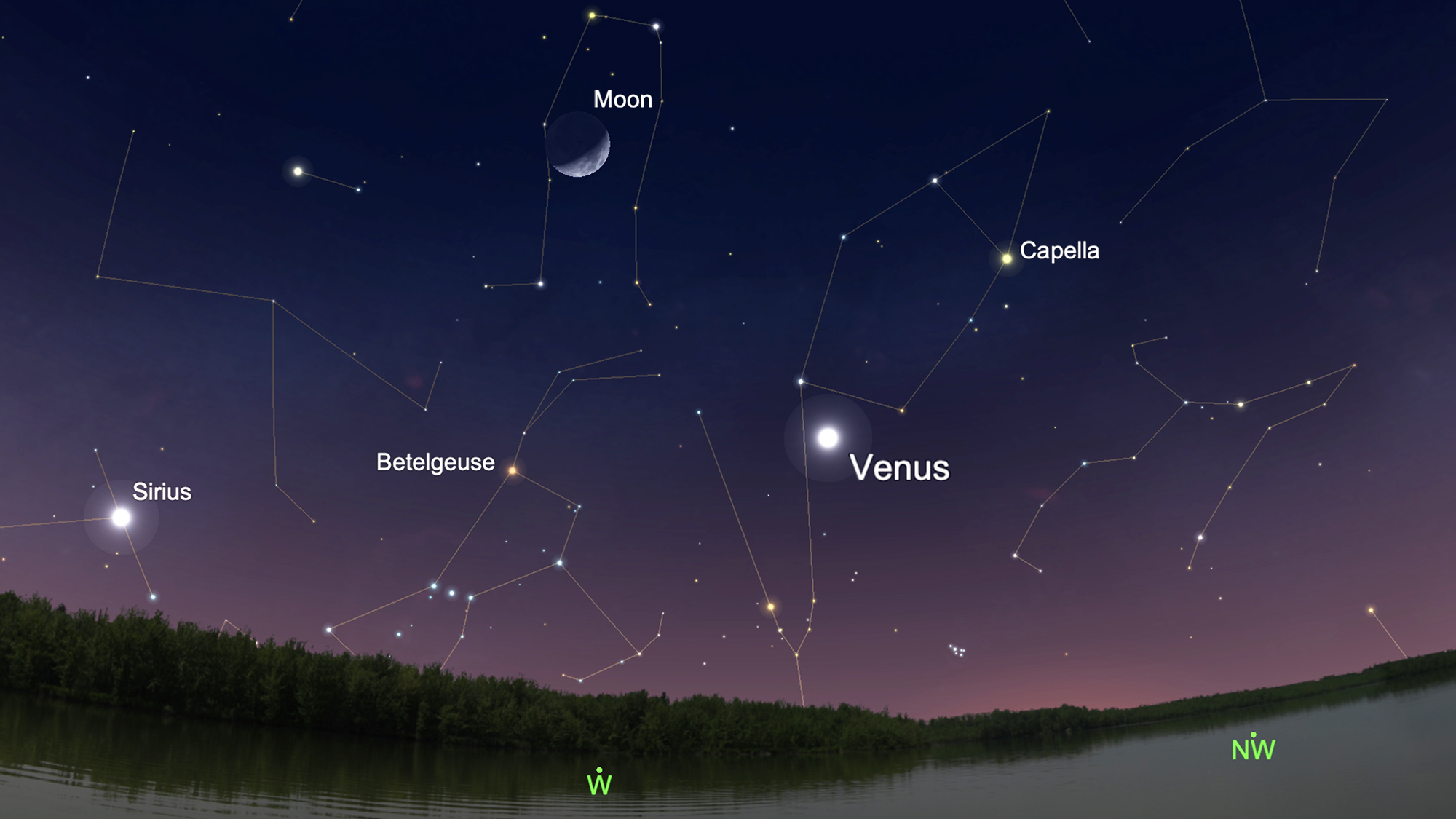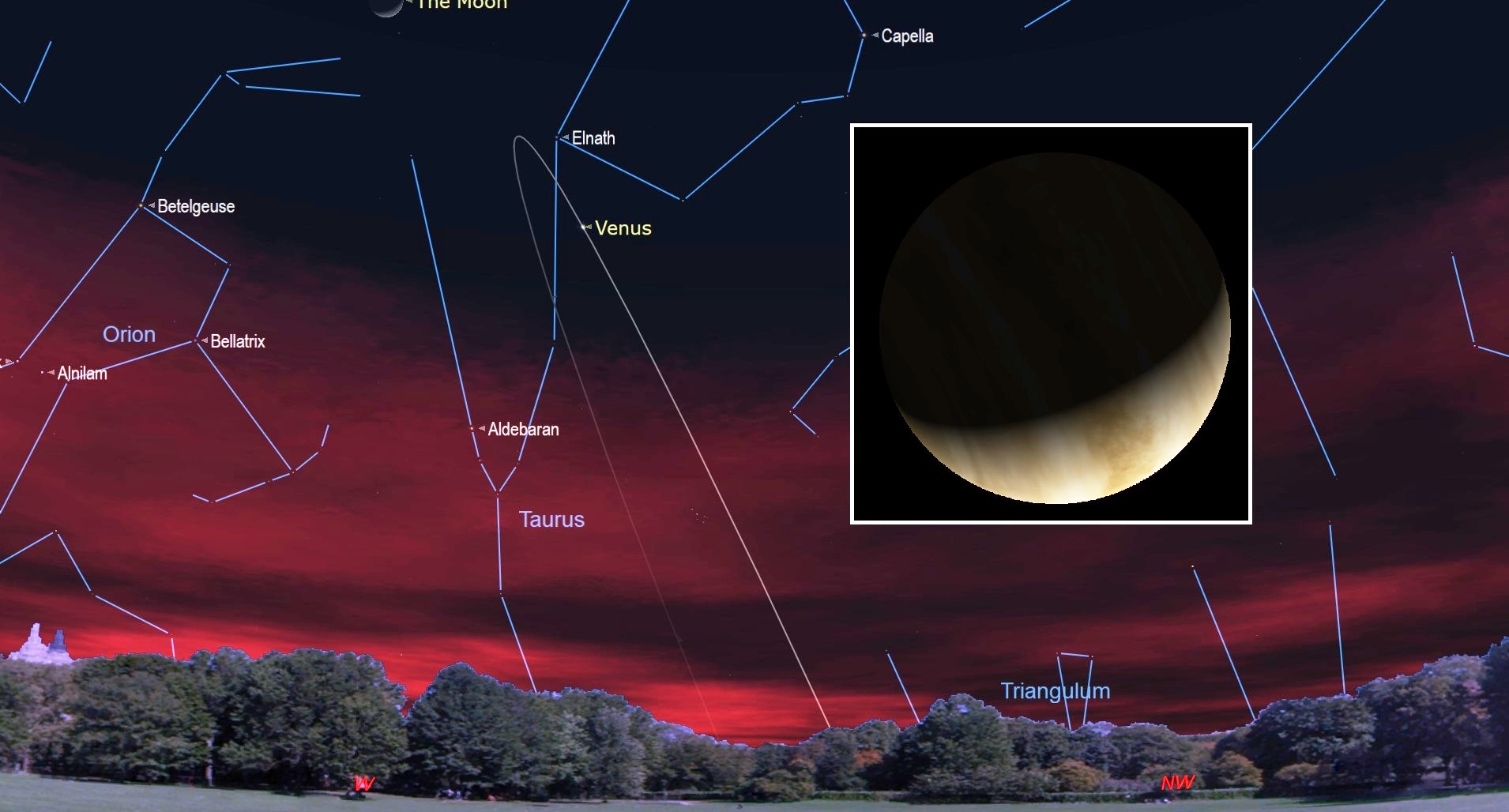Venus shines at its brightest of the year tonight! Here's how to see it.
Venus, the most brilliant planet in the night sky, will be shining at its brightest tonight (April 28).
The "evening star," which is already the second-brightest object in the night sky (second only to the moon), is now shining at magnitude -4.7, or nearly three times brighter than it was at its faintest in late 2019. (Magnitude is a logarithmic scale of brightness used by astronomers, with lower numbers denoting brighter objects and negative numbers indicating exceptionally bright objects.)
Venus is now so bright that keen-eyed observers may be able to spot it in broad daylight, although the planet is best viewed after sunset. Look for the planet above the west-southwest horizon as the skies begin to darken this evening. It will be in the Taurus constellation near Elnath, the second-brightest star in Taurus that represents the tip of the right "horn" of the bull.
Related: April is the month of Venus! See the 'evening star' at its brightest

For skywatchers in New York City, Venus rises by 6 a.m. and sets at 11:24 p.m. local time, which is about 3.5 hours after sunset. The "evening star" will be visible after sunset regardless of your location, but you can find out exactly what time the sun, moon and planets rise and set from any location using his handy night sky calculator at timeanddate.com.
Venus will continue to reign in the evening sky until June 3, when the planet reaches inferior solar conjunction, or the point in its orbit where it is almost directly between Earth and the sun. At this time, Venus will be difficult to see, because it rises and sets at the same time as the sun and will be overpowered by the sun's powerful glare.
In the days following inferior conjunction, Venus will reappear in the dawn sky as a "morning star." The planet will reach the greatest brightness of its morning apparition on July 10, when it will once again shine at a dazzling magnitude of -4.7.
Get the Space.com Newsletter
Breaking space news, the latest updates on rocket launches, skywatching events and more!

Venus reached its "greatest illuminated extent" — when the illuminated part of the planet's surface covers the largest chunk of our night sky — on Monday (April 27) at 9 p.m. EDT (0100 GMT on April 28), according to the skywatching site EarthSky.org.
Perhaps surprisingly, Venus is only about 25% illuminated by sunlight at this time, and the planet appears as a thin crescent in small telescopes and high-power binoculars. And despite the fact that its Earth-facing side is almost entirely dark, Venus now appears nearly 40% larger in size than it did just one month ago.
Venus' crescent will continue to grow thinner as the planet approaches inferior solar conjunction in early June. Once it reappears from the sun's glare a few days later, it will remain in the dawn sky as a "morning star" for the rest of the year.
Editor's note: If you snap an amazing night sky photo that you'd like to share with us and our news partners for a possible story or image gallery, send images and comments to us at spacephotos@space.com.
- Examining the phases of Venus
- The 10 weirdest facts about Venus
- When, where and how to see the planets in the 2020 night sky
Email Hanneke Weitering at hweitering@space.com or follow her @hannekescience. Follow us on Twitter @Spacedotcom and on Facebook.
OFFER: Save 45% on 'All About Space' 'How it Works' and 'All About History'!
For a limited time, you can take out a digital subscription to any of our best-selling science magazines for just $2.38 per month, or 45% off the standard price for the first three months.
Join our Space Forums to keep talking space on the latest missions, night sky and more! And if you have a news tip, correction or comment, let us know at: community@space.com.

Hanneke Weitering is a multimedia journalist in the Pacific Northwest reporting on the future of aviation at FutureFlight.aero and Aviation International News and was previously the Editor for Spaceflight and Astronomy news here at Space.com. As an editor with over 10 years of experience in science journalism she has previously written for Scholastic Classroom Magazines, MedPage Today and The Joint Institute for Computational Sciences at Oak Ridge National Laboratory. After studying physics at the University of Tennessee in her hometown of Knoxville, she earned her graduate degree in Science, Health and Environmental Reporting (SHERP) from New York University. Hanneke joined the Space.com team in 2016 as a staff writer and producer, covering topics including spaceflight and astronomy. She currently lives in Seattle, home of the Space Needle, with her cat and two snakes. In her spare time, Hanneke enjoys exploring the Rocky Mountains, basking in nature and looking for dark skies to gaze at the cosmos.










